Rotor Investigation of High-Speed Permanent Magnet Motor with Roundness Error and CFD-Thermal Distribution Analysis
Abstract
:1. Introduction
2. Motor Structure
3. Rotor Sleeve Analysis
3.1. Theoretical Analysis of Eddy Current Loss with Sleeve
3.2. Eddy Current Loss Calculation with Different Sleeve Conductivity
3.3. Eddy Current Loss Calculation at Different Rotational Speed
3.4. Calculation of Mechanical Stress at Different Sleeve Thicknesses
4. Analysis of Air Friction Loss of HSPMSM
4.1. The Effect of Rotational Speed on the Air Friction Loss
4.2. The Effect of Roundness Error on Air Friction Loss
4.2.1. Mathematical Model of Motor Air Gap Considering Sleeve Roundness Error
- (1)
- The airflow in the air gap of the motor is an incompressible fluid;
- (2)
- The effect of air gravity is not considered;
- (3)
- The airflow in the air gap is turbulent;
4.2.2. The Variation Law of Air Friction Loss on the Outer Surface of the Rotor
4.2.3. Analysis of the Effect of Forced Air-Cooling Inlet Velocity on the Air Friction Loss
5. Analysis of Overall Motor Loss
6. HSPMSM Thermal Analysis
7. Experimental Verification
8. Conclusions
- (1)
- The influence of sleeve material conductivity, rotating speed and sleeve thickness on the eddy current loss can be summarized, providing some reference of the research for the rotor sleeve of high-speed motor, especially for titanium alloy sleeve. The eddy current loss of the sleeve is expressed as followings.
- (2)
- By analyzing the relationship between rotor sleeve material, thickness and rotor eddy current loss and mechanical stress, it is concluded that in this thesis, the sleeve made of titanium alloy material with a thickness of 3.5 mm is chosen to effectively suppress the rotor eddy current loss in high-speed motors.
- (3)
- The air friction loss becomes significant at the high-speed motor. It will rapidly increase to high-speed rotational rotors. The influences of the roundness error, the rational speed and the axial forced-air velocity on air-friction loss are analyzed in detail, which provide a reference of calculate the air friction loss of HSPMM.
- (4)
- By analyzing the roundness error, it can be concluded that the overall maximum motor temperature tends to decrease, and the air gap pressure tends to increase with the increase of the motor forced air cooling inlet velocity for a fixed roundness error. Through comprehensive analysis of the relationship between the flow rate of forced air cooling and rotor temperature, air friction loss and air pressure, the optimal air inlet velocity is 10 m/s. Furthermore, the air friction loss is concluded with roundness error (AErr) as following, providing some reference for the rotor design of HSPMM.
- (5)
- The influence of stator temperature on the rotor was analyzed by coupled magnetic-thermal multi-physical field calculations. The forced-air inlet velocity of 10 m/s is adopted by studying the air friction loss due to the roundness error, avoiding rotor overheating, in the paper.
- (6)
- The loss separation method is used to obtain the air friction loss measurement results. The accuracy of the finite element calculation results of air friction loss is verified through the experimental data. Under load testing, the stator winding temperature in FEA calculation is verified by experiment on the basis of resistance change method. The temperature maximal difference is 5.5%, which is acceptable.
Author Contributions
Funding
Institutional Review Board Statement
Informed Consent Statement
Data Availability Statement
Conflicts of Interest
Appendix A
References
- Jung, Y.-H.; Park, M.-R.; Kim, K.-O.; Chin, J.-W.; Hong, J.-P.; Lim, M.-S. Design of high-speed multilayer IPMSM using ferrite PM for EV traction considering mechanical and electrical characteristics. IEEE Trans. Ind. Electron. 2021, 57, 327–339. [Google Scholar] [CrossRef]
- Du, G.; Xu, W.; Zhu, J. Power loss and thermal analysis for high power high speed permanent magnet machines. IEEE Trans. Ind. Electron. 2019, 99, 1–10. [Google Scholar] [CrossRef]
- Tong, W.; Sun, R.; Zhang, C. Loss and thermal analysis of a high-speed surface-mounted PMSM with amorphous metal stator core and titanium alloy rotor sleeve. IEEE Trans. Magn. 2019, 55, 10–14. [Google Scholar] [CrossRef]
- Tong, W.; Dai, S.; Wu, S. Performance comparison between an amorphous metal PMSM and a silicon steel PMSM. IEEE Trans. Magn. 2019, 55, 1–5. [Google Scholar] [CrossRef]
- Payza, O.; Demir, Y.; Aydin, M. Investigation of losses for a concentrated winding high-speed permanent magnet-assisted synchronous reluctance motor for washing machine application. IEEE Trans. Magn. 2018, 54, 1–5. [Google Scholar] [CrossRef]
- Yang, C.; Zhang., Y.; Qiu., H. Influence of Output Voltage Harmonic of Inverter on Loss and Temperature Field of Permanent Magnet Synchronous Motor. IEEE Trans. Magn. 2019, 55, 1–5. [Google Scholar] [CrossRef]
- Chen, W.; Ju, Y.; Yan, D.; Guo, L.; Geng, Q.; Shi, T. Design and optimization of dual-cycled cooling structure for fully-enclosed permanent magnet motor. Appl. Therm. Eng. 2019, 152, 338–349. [Google Scholar] [CrossRef]
- Xu, X.; Ge, B.; Tao, D.; Han, J.; Wang, L. Effect of helium on temperature rise of helium blower drive motor in high-temperature gas-cooled reactor. Appl. Therm. Eng. 2019, 159, 113888. [Google Scholar] [CrossRef]
- Dong, H.; Ruan, L.; Wang, Y.; Yang, J.; Liu, F.; Guo, S. Performance of air/spray cooling system for large-capacity and high-power-density motors. Appl. Therm. Eng. 2021, 192, 116925. [Google Scholar] [CrossRef]
- Ge, B.; Jiong, Z.; Tao, D. Temperature prediction and cooling structure optimization of explosion-proof high pressure water-cooled double speed motor. Energy Rep. 2022, 8, 3891–3901. [Google Scholar]
- Seounghwan, H.; Chiwon, K.; Kwan-Soo, L. Thermal enhancement of an air-cooled motor with a flow guide. Int. J. Heat Mass Transf. 2022, 183, 122228. [Google Scholar]
- Ai, M.; Liu, W.; Xu, Z. Research on energy saving and thermal management of high-efficiency and high-voltage motor based on fluid network decoupling. Energy Rep. 2021, 7, 8332–8345. [Google Scholar] [CrossRef]
- Pei, Z.; Zhao, J.; Song, J.; Zong, K.; He, Z.; Zhou, Y. Temperature Field Calculation and Water-Cooling Structure Design of Coreless Permanent Magnet Synchronous Linear Motor. IEEE Trans. Ind. Electron. 2021, 68, 1065–1076. [Google Scholar] [CrossRef]
- Blaž, B.; Janez, R.; Janez, P.; Jože, T. Failure modes and life prediction model for high-speed bearings in a through-flow universal motor. Eng. Fail. Anal. 2021, 128, 105535. [Google Scholar]
- Zhang, J.; Wen, H.; Tang, L. Improved smoothing frequency shifting and filtering algorithm for harmonic analysis with systematic error compensation. IEEE Trans. Ind. Electron. 2019, 66, 9500–9509. [Google Scholar] [CrossRef]
- Fang, H.; Li, D.; Qu, R.; Li, J.; Wang, C.; Song, B. Rotor Design and Eddy-Current Loss Suppression for High-Speed Machines With a Solid-PM Rotor. IEEE Trans. Ind. Appl. 2019, 55, 448–457. [Google Scholar] [CrossRef]
- Song, C.; Jiao, L.; Wang, X.; Liu, Z.; Shen, W.; Chen, H.; Qian, Y. Development and testing of a muti-sensor measurement system for roundness and axis straightness errors of deep-hole parts. Measurement 2022, 29, 111069. [Google Scholar] [CrossRef]
- Zhang, P.; Chen, Y.; Liu, X. Relationship between roundness errors of shaft and radial error motions of hydrostatic journal bearings under quasi-static condition. Precis. Eng. 2018, 51, 564–576. [Google Scholar] [CrossRef]
- Jing, L.; Pan, Y.; Wang, T.; Qu, R.; Cheng, P.-H. Transient Analysis and Verification of a Magnetic Gear Integrated Permanent Magnet Brushless Machine with Halbach Arrays. IEEE J. Emerg. Sel. Top. Power Electron. 2022, 10, 1881–1890. [Google Scholar] [CrossRef]
- David, K. CHENG. Field and Wave Electromagnetics, 2nd ed.; Pearson Education Limited: New York, NY, USA, 2018; pp. 335–346. [Google Scholar]
- Shen, J.X.; Qin, X.F.; Yao, L.; Wang, Y.C. Rotor Strength Analysis and Retaining Sleeve Design for High-speed PM Machines. Proc. CSEE 2021, 42, 2334–2346. [Google Scholar]
- Gao, Q.X.; Wang, X.L.; Ding, Q.; Shao, Y.Y. Strength Analysis and Structure Design of Ultra High-Speed Micro Permanent Magnet Motor Rotor. Proc. CSEE 2021, 41, 2856–2857. [Google Scholar]
- Shi, Z.; Zhang, W.; Chen, Q.; Yang, L.; Li, Q. Interference fit calculation and analysis for rotor sleeve of high-speed micro permanent magnet electric motor. Small Spec. Electr. Mach. 2014, 42, 35–39. [Google Scholar]
- Chen, J.; Zheng, C.; Bai, Y.; Zhou, L.; Hua, H. Interference Fit Calculation and Strength Verification for Rotor Sleeve of Permanent Magnet Motor Operating on High Speed. Small Spec. Electr. Mach. 2015, 43, 21–24. [Google Scholar]
- Huang, Z.; Fang, J.; Liu, X.; Han, B. Loss calculation and thermal analysis of rotors supported by active magnetic bearings for high-speed permanent-magnet electrical machines. IEEE Trans. Ind. Electron. 2016, 63, 2027–2035. [Google Scholar] [CrossRef]
- Wang, J.; Wang, F.; Kong, X. Losses and Thermal Analysis of Highspeed PM Machine. In Proceedings of the 2008 Joint International Conference on Power System Technology and IEEE Power India Conference, New Delhi, India, 12–15 October 2008; pp. 1–5. [Google Scholar]
- Dems, M.; Komeza, K.; Lecointe, J.-P. Variation of additional losses at no-load and full-load for a wide range of rated power induction motors. Electr. Power Syst. Res. 2017, 143, 692–702. [Google Scholar] [CrossRef]
- Jing, L.; Tang, W.; Wang, T.; Ben, T.; Qu, R. Performance Analysis of Magnetically Geared Permanent Magnet Brushless Motor for Hybrid Electric Vehicles. IEEE Trans. Transp. Electrif. 2022, 8, 2874–2883. [Google Scholar] [CrossRef]
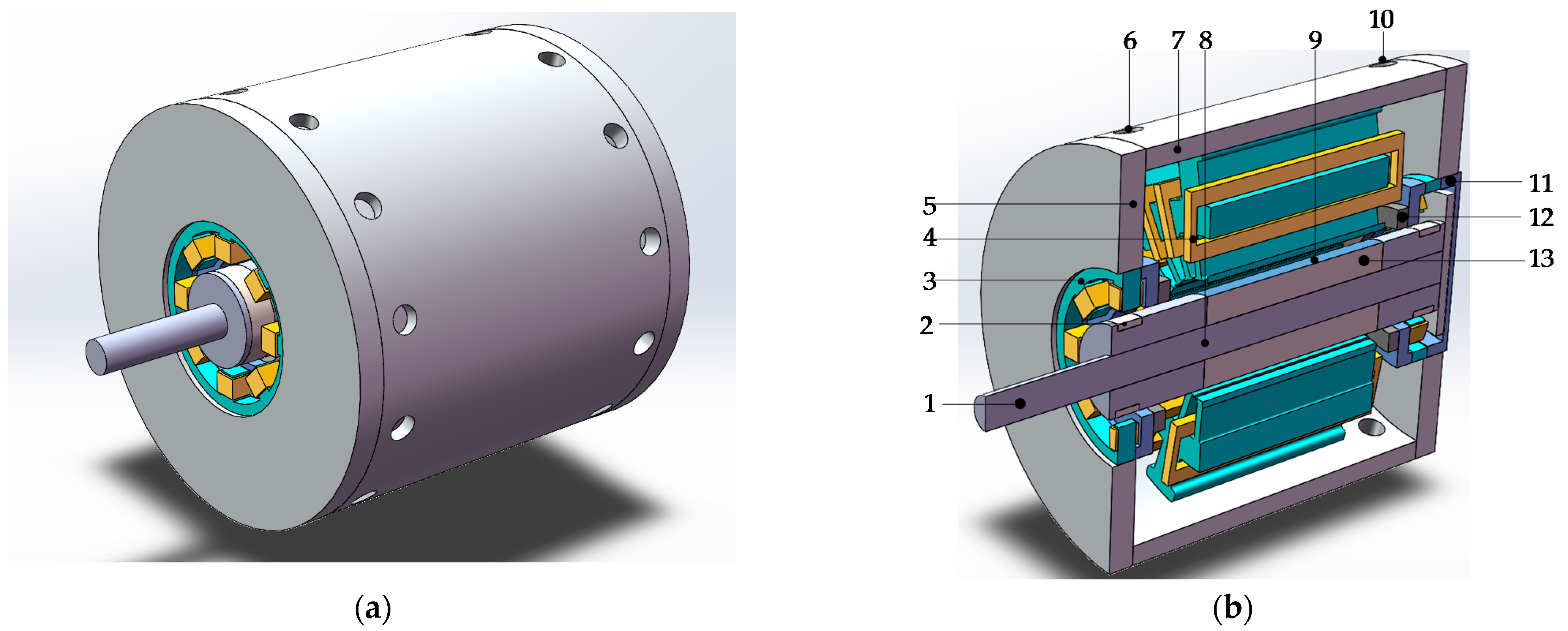
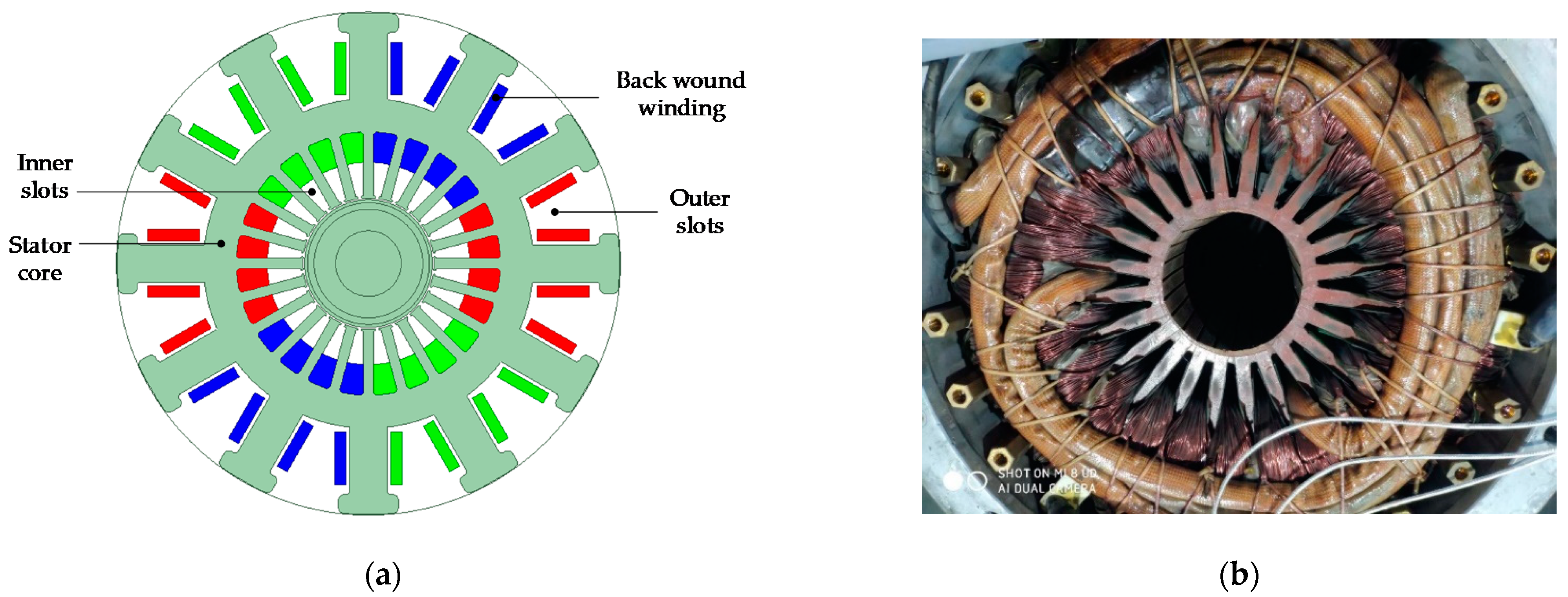
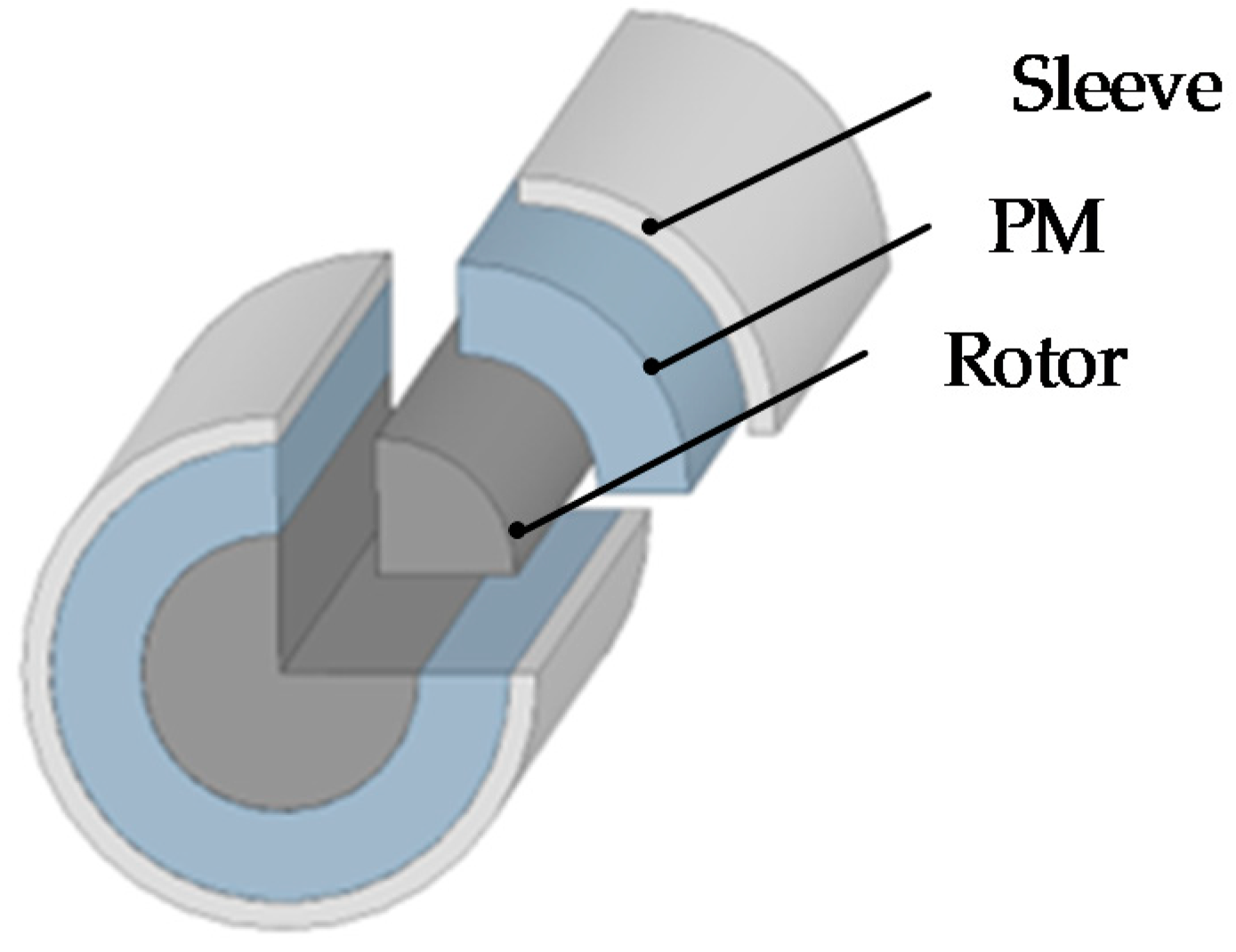

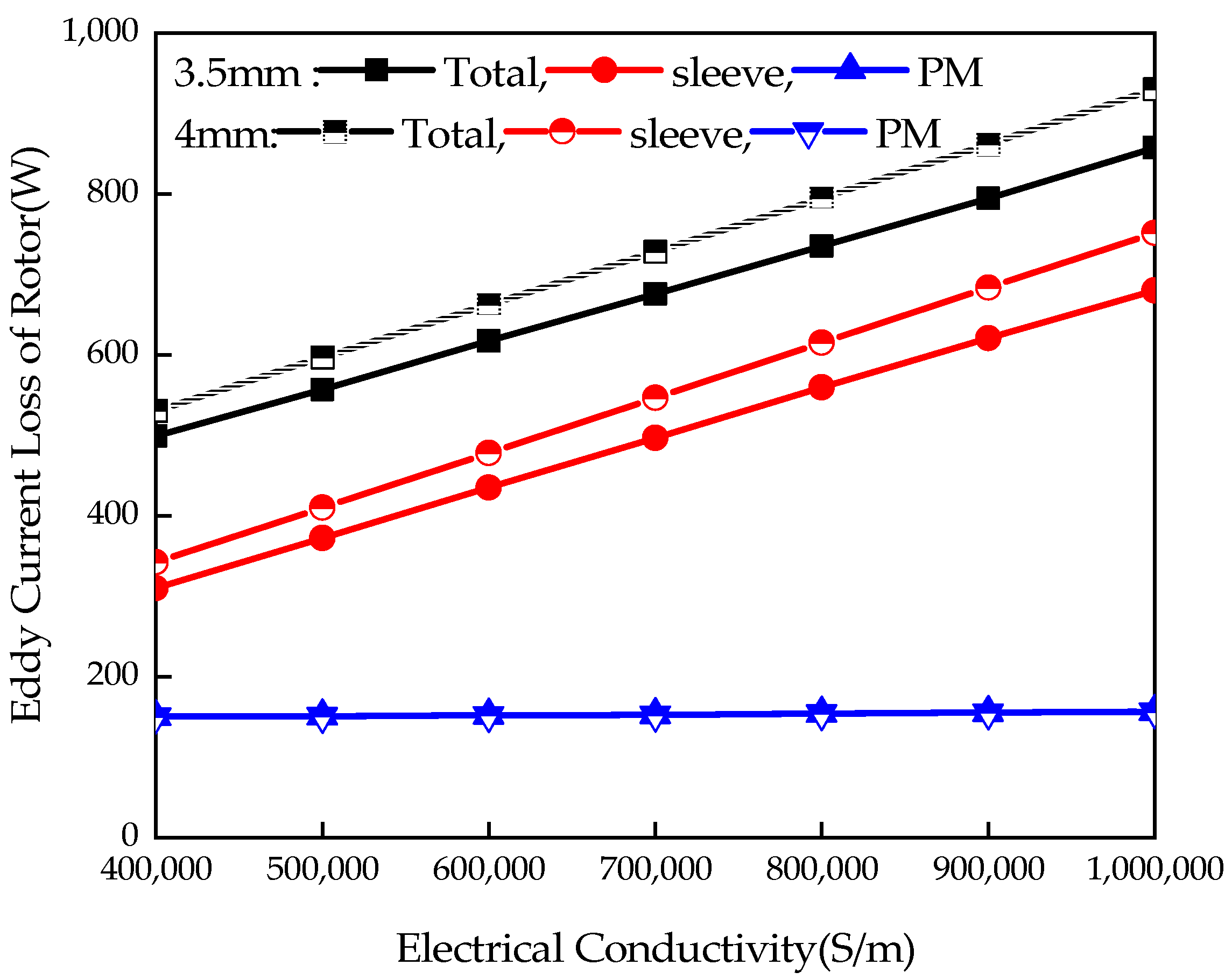

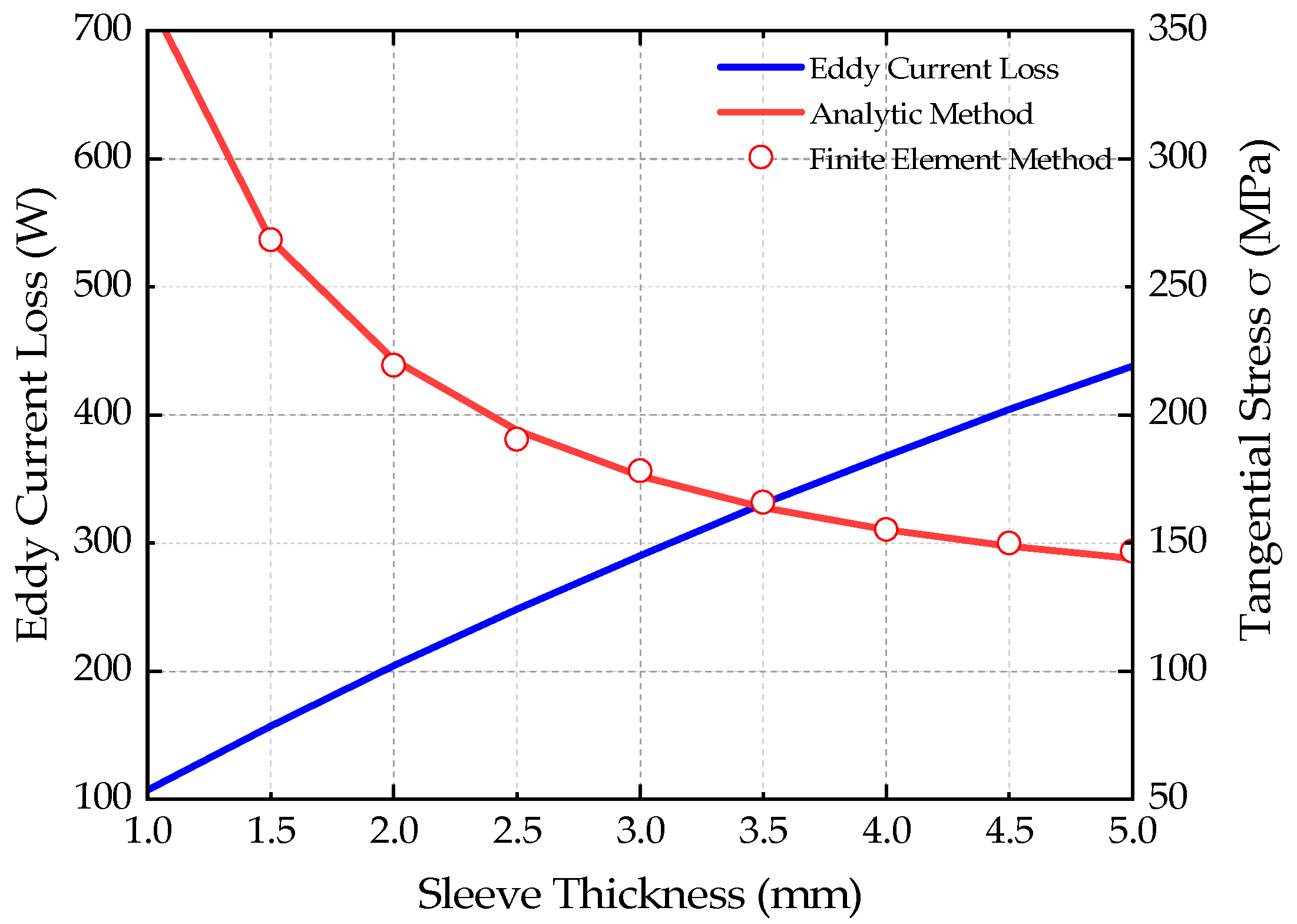


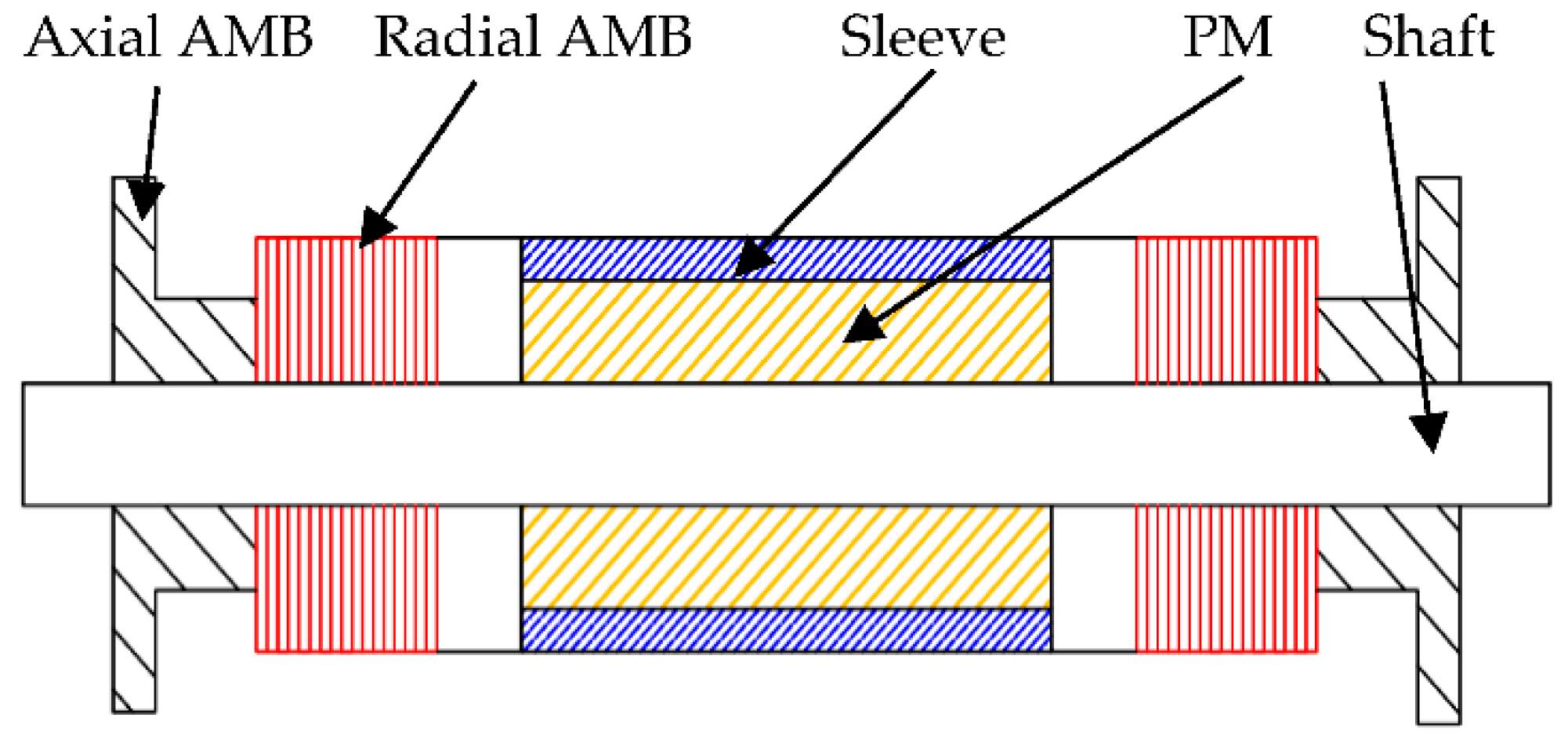












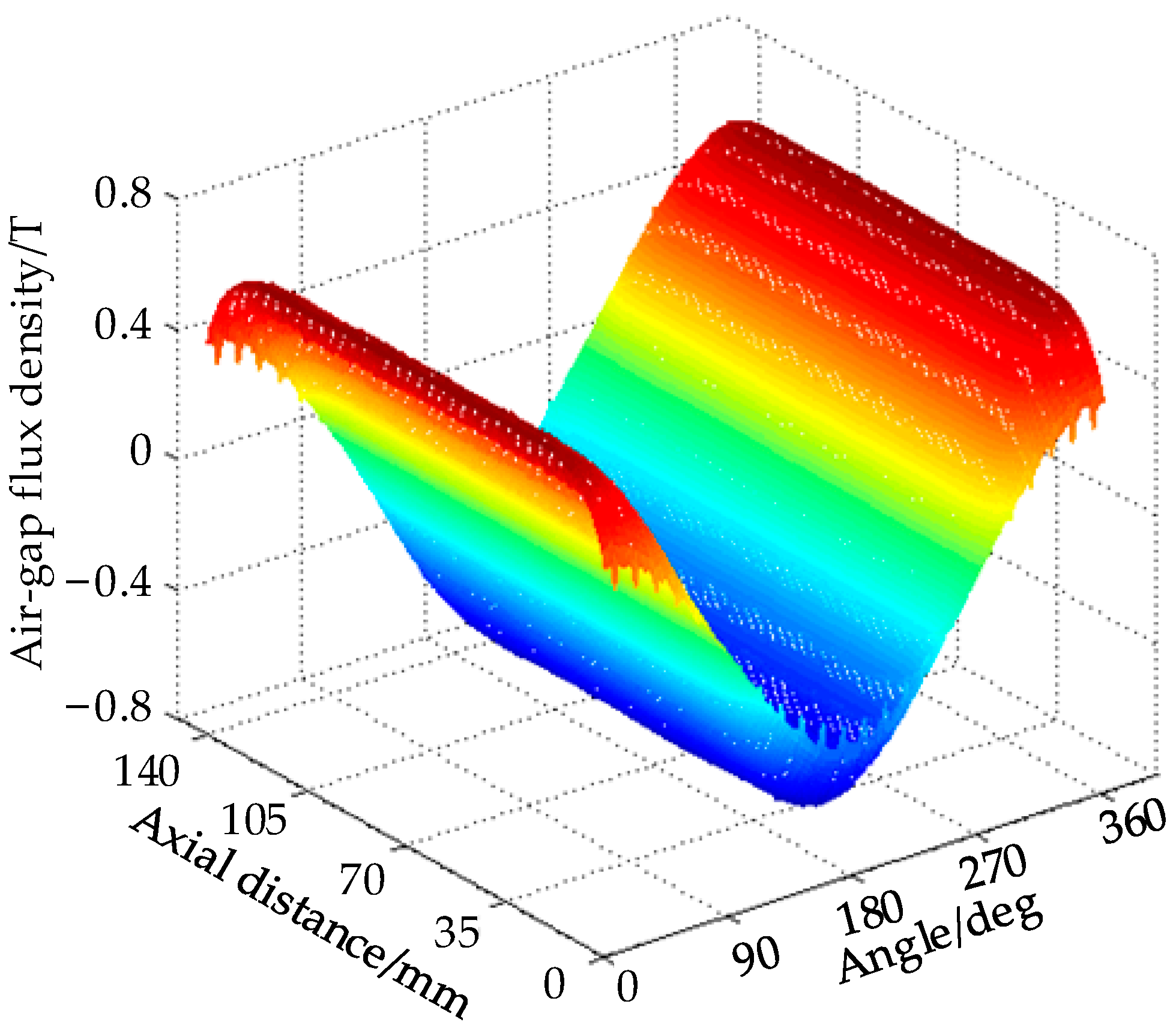
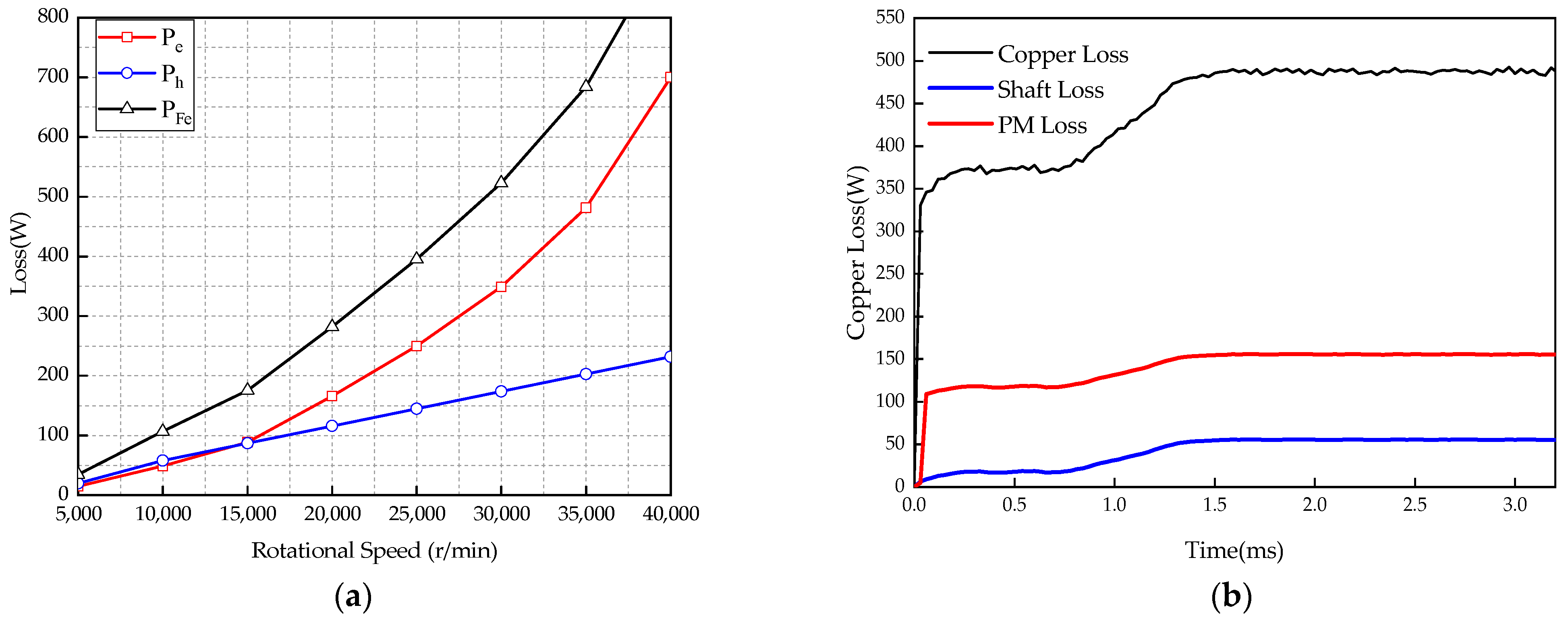




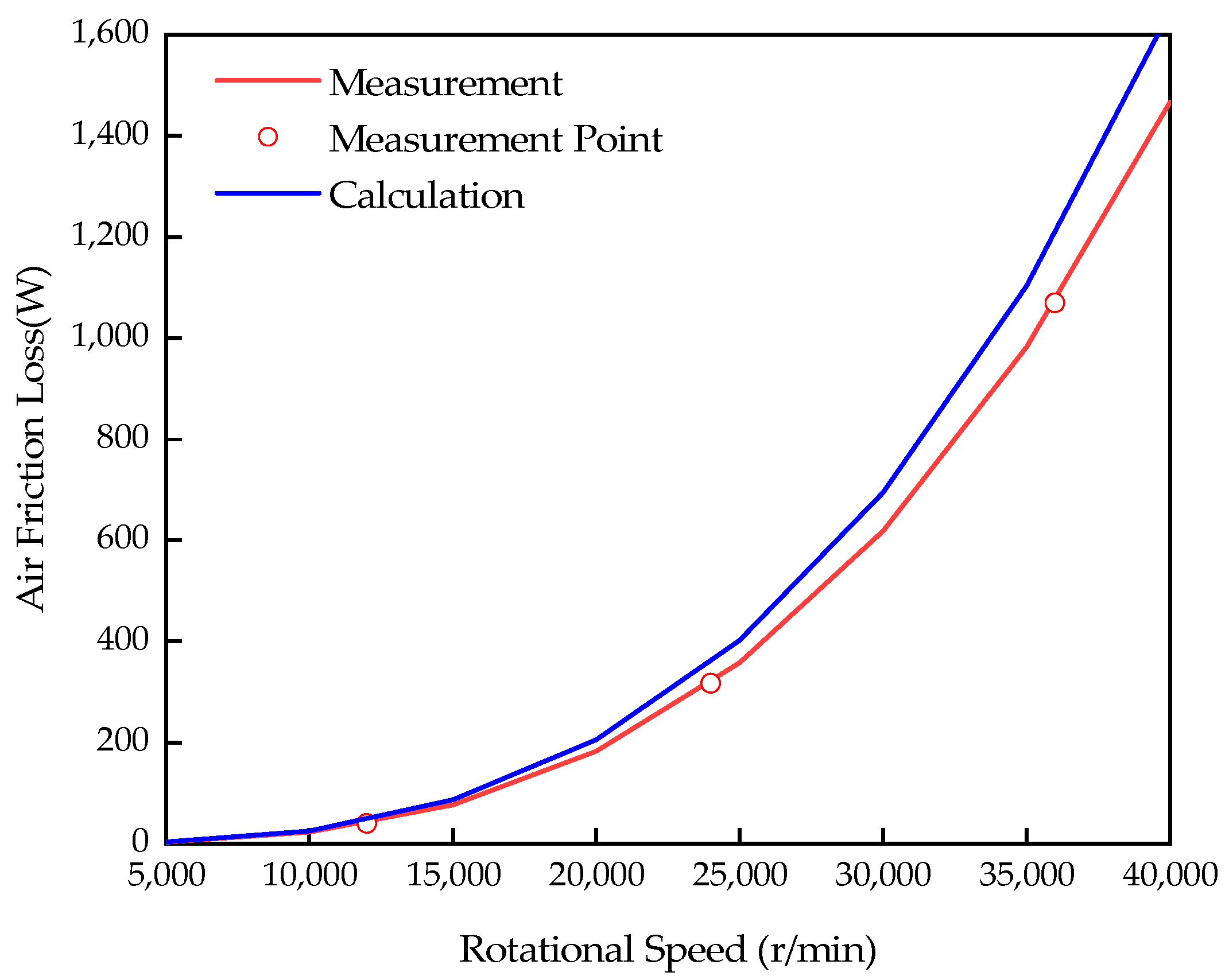
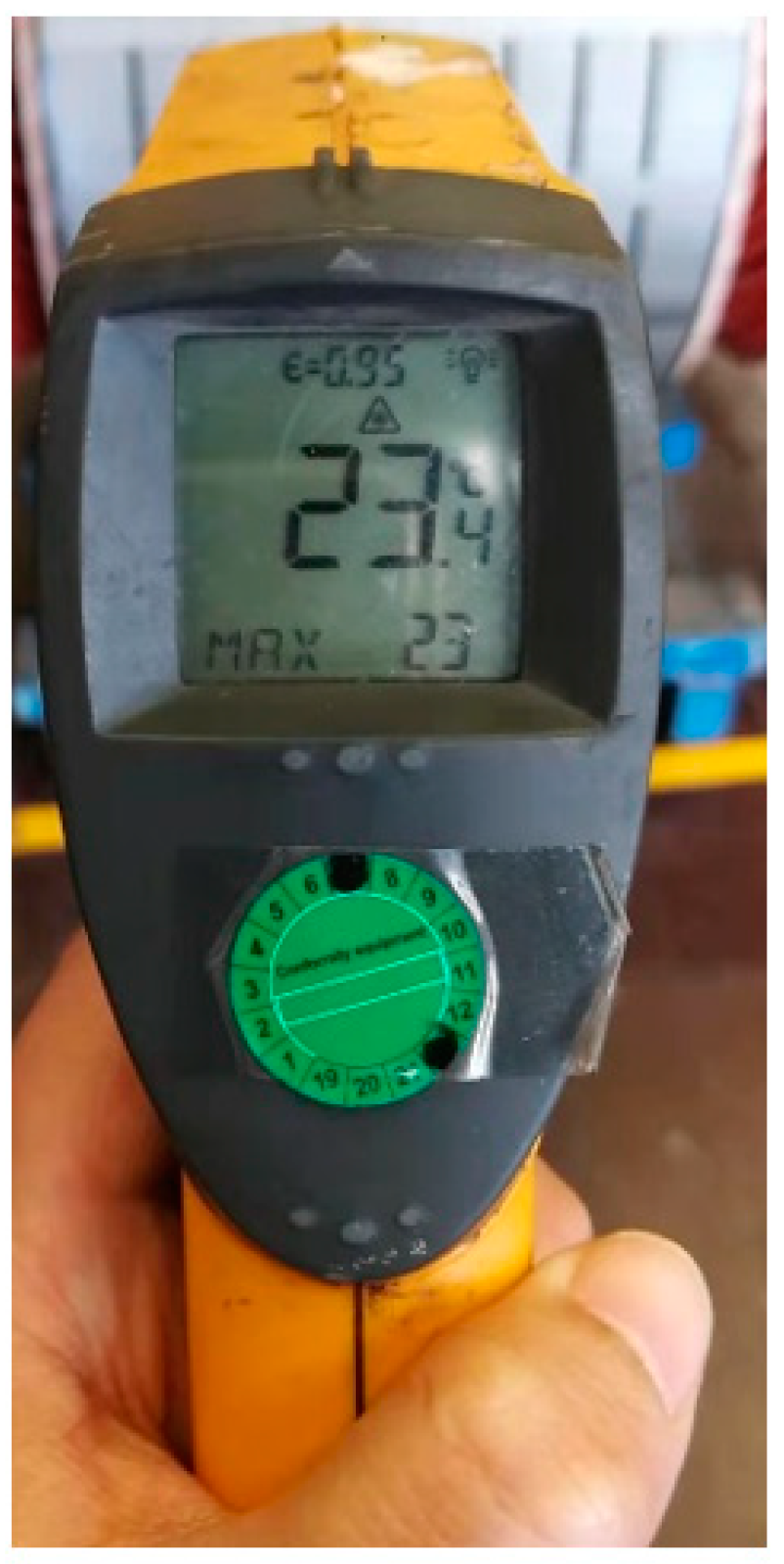
| Parameter | Value | Unit |
|---|---|---|
| Rated Power | 105 | kW |
| Rated speed | 36,000 | r/min |
| Number of poles | 2 | |
| Frequency | 600 | Hz |
| Efficiency | 95 | % |
| Power factor | 0.94 | |
| Inner and outer slot area ratio | 2/5 | |
| Outer diameter of stator core | 180 | mm |
| Stator Core length | 140 | mm |
| Phases resistance | 1785 | Ω |
| Slot fill factor | 60 | % |
| Air gap length | 2.5 | mm |
| Rotor outer diameter | 65 | mm |
| PM grade | N33EH | |
| Remanent flux density of PM/Br | 1.15 | T |
| Intrinsic coercivity of PM/Hcj | 30 | kOe |
| Material | Heat Conduction Coefficient (W/m·K) | Density (g/cm3) | Specific Heat Capacity (J/g·°C) |
|---|---|---|---|
| Titanium alloy | 7.955 | 4.51 | 0.612 |
| Stainless steel | 16.3 | 7.9 | 0.46 |
| Carbon fiber | 0.7 | 1.8 | 0.170 |
| Geometric Parameters | Value (mm) |
|---|---|
| Rotor outer diameter | 65 |
| Stator inner diameter | 70 |
| Core length | 140 |
| Roundness error amplitude | 0; 0.1; 0.2 0.3; 0.4; 0.5 |
| Roundness Error Type | Magnitude (mm) | Tangential Stress (N) | Rotor Surface Air Friction Loss (W) |
|---|---|---|---|
| ellipsoidal | 0 | 5.18 | 1152.7 |
| 0.1 | 5.38 | 1162.8 | |
| 0.2 | 5.51 | 1187.9 | |
| 0.3 | 5.67 | 1227.3 | |
| 0.4 | 5.89 | 1297.1 | |
| 0.5 | 6.01 | 1397.5 |
| Loss | Value/W |
|---|---|
| Stator copper loss | 500 |
| Stator iron loss–Eddy current loss | 503 |
| Stator iron loss–Hysteresis loss | 211 |
| Rotor eddy current loss of sleeve | 310 |
| Rotor PM loss | 151 |
| Shaft loss | 56 |
| Air friction loss | 2150 |
| Mechanical additional loss | 1120 |
| Total loss | 5001 |
| n (r/min) | f (Hz) | PFe (W) | Pfric (W) | Padd0 (W) | Measured P0 (W) |
|---|---|---|---|---|---|
| 12,000 | 200 | 129 | 40 | 78 | 247 |
| 24,000 | 400 | 374 | 317 | 78 | 769 |
| 36,000 | 600 | 697 | 1107 | 78 | 1844 |
| Part | FEA Result | Experiment Result | Unit | Tolerance |
|---|---|---|---|---|
| Winding | 123 | 117.5 | °C | 4.7% |
| Shell | 52 | 49.3 | °C | 5.5% |
| Inlet right Shaft | 64.5 | 61.2 | °C | 5.4% |
Publisher’s Note: MDPI stays neutral with regard to jurisdictional claims in published maps and institutional affiliations. |
© 2022 by the authors. Licensee MDPI, Basel, Switzerland. This article is an open access article distributed under the terms and conditions of the Creative Commons Attribution (CC BY) license (https://creativecommons.org/licenses/by/4.0/).
Share and Cite
Du, J.; Li, C.; Zhao, J.; Huang, X.; Liu, Y.; Lv, H. Rotor Investigation of High-Speed Permanent Magnet Motor with Roundness Error and CFD-Thermal Distribution Analysis. Energies 2022, 15, 4606. https://doi.org/10.3390/en15134606
Du J, Li C, Zhao J, Huang X, Liu Y, Lv H. Rotor Investigation of High-Speed Permanent Magnet Motor with Roundness Error and CFD-Thermal Distribution Analysis. Energies. 2022; 15(13):4606. https://doi.org/10.3390/en15134606
Chicago/Turabian StyleDu, Jingjuan, Chaojiang Li, Jian Zhao, Xinyu Huang, Yupeng Liu, and Haiying Lv. 2022. "Rotor Investigation of High-Speed Permanent Magnet Motor with Roundness Error and CFD-Thermal Distribution Analysis" Energies 15, no. 13: 4606. https://doi.org/10.3390/en15134606
APA StyleDu, J., Li, C., Zhao, J., Huang, X., Liu, Y., & Lv, H. (2022). Rotor Investigation of High-Speed Permanent Magnet Motor with Roundness Error and CFD-Thermal Distribution Analysis. Energies, 15(13), 4606. https://doi.org/10.3390/en15134606







